![]()
- Footnotes in History -
While searching through old microfilm looking for information on past Kentucky games, it's hard to not be distracted by all the other tidbits of information which catch your eye, both inside and outside sports. Often there are some interesting bits of information which do relate to UK basketball in some way or things which are not well known but turn out to be significant in some way.
I try to note this type of information when I see it, and in the past have taken a few of them and written them up as posts to on message boards to provide a different dimension to the topics (and to help pass away the dog days of summer.) Below I've taken some of these posts and put them together in one place and with some additional links and graphics. Some of the information is interesting, some important points in history (whether it was known at the time or not) and some is just goofy. Hope you enjoy them.
![]()
![]()
Dateline Spring 1902 - Birth of Big Blue
While looking through some archives at the UK library, I ran across an article published on January 8, 1961 in the Louisville Courier-Journal weekly magazine entitled "Birth of the Big Blue." This was written by the Courier-Journal's Lexington correspondant Gerald Griffin.
The article basically talks about some of the early days in UK basketball history, and interviews three people: former player Dr. H.H. Downing (who played in 1908), former coach and administrator S.A. "Daddy" Boles (who came to Kentucky in 1916 and was the head basketball coach in 1918) and former player Dr. E. Cronley Elliott.
It was Elliott who caught my eye, since I had never heard of him and I knew of no record of him ever playing basketball for Kentucky. Reading further it became apparent as to why, since Elliott claims in the article that he played basketball in 1902; a year before the first official game was known to have been played at Kentucky (February 6, 1903 against Georgetown College.
According to the article:
"This century was an infant when the University of Kentucky, then known as Kentucky State College, annoyed the taxpayers by building its first gymnasium on the Lexington campus.
It wasn't much by modern standards, but it provided shelter for a few athletic young men eager to work off steam during the long dry season between football and baseball. So they formed a basketball team.
That carefree decision in 1902, could be called the birth of the Big Blue.
Dr. E. Cronley Elliott, a retired Lexington dentist, was a member of that hardy crew which played for fun, without coach, captain or athletic scholarships."
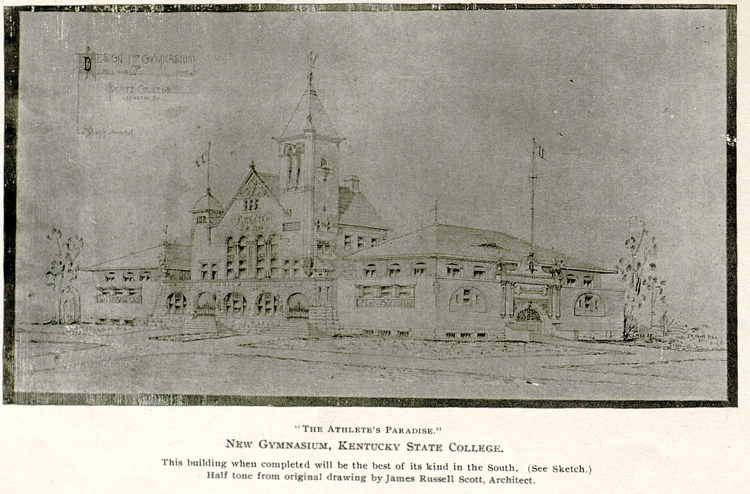 |
I had not heard of cases where students played basketball in the gymnasium prior to the official games held in 1903, but I wasn't surprised at reading this since it would seem to be natural that the students would take advantage of a gymnasium as soon as it opened.
Although there are some discrepancies in the literature as to when the gymnasium in Barker Hall actually became available to students, it appears likely that it was early in 1902. This is based on claims (in the 1904 yearbook and elsewhere) that the women actually had formed a basketball squad in 1902, along with articles in late 1901 in the Lexington Leader stating that the gymnasium was nearly complete and ready to be handed over to the University in conjunction with the decision by the College in to create a Physical Eduction Department and to hire a gymnasium instructor for the women, Frances Offutt, in December of 1901.
What did strike my curiosity was the claim by Elliott that not only did they play in the gym for fun, but that they played games against the local Lexington YMCA.
Again, according to the article:
"The team didn't even have a schedule the year Dr. Elliott played, although that forerunner of the celebrated Wildcats of recent years did play a couple of games with a team representing the Lexington Y.M.C.A."
 |
Beyond that, it's extremely unlikely that these games were officially sanctioned or endorsed in any way by the University given the general hostility by the administration toward organized athletics at the time. If anything, it is surprising that basketball at Kentucky started as early as it did. As Gregory Kent Stanley noted in his book Before Big Blue "UK's first president, James Kennedy Patterson, attempted to ban all sports, believing that their legacy was limited to broken noses, legs, and arms, wasted time, idleness and 'a heritage of demoralization.'"
So while the information in this article likely will never be sufficient to alter the official record, it does give a glimpse into an earlier, previously forgotten time, and provides a reminder that there are still areas to be explored when looking back through Kentucky's rich basketball history.
As a follow-on to this, I should note that upon reading Elliott's claim, I wanted to verify that he indeed was present at Kentucky during the time stated (1902) and confirm that he wasn't mistakenly thinking of the 1903 season where he potentially could have been one of the group of students who were loosely organized under Walter Mustaine and instructed to start playing basketball (as described by Russell Rice in his book Big Blue Machine.)
One notable difference suggesting they were distinct situations concerned the game ball. In the Courier-Journal article it was noted: "In Dr. Elliott's time they wore gym suits which they bought themselves. But the school generously provided them with a ball and hung iron hoops at each end of the gym."
In comparison, Rice's account of the 1903 team in Big Blue Machine specifically mentions that the players were responsible for raising money to purchase a ball. From Big Blue Machine:
"I remember chipping in to help buy the ball," said Thomson R. "Tommie" Bryant, who had just turned 90 in January of 1975. "It was one of those you inflated with a foot pump and then laced. If something had happened to it, we couldn't have played."
Based simply on this discrepancy over the ball, they appear to be different situations. It does make one wonder what happened to the ball in 1902 however!
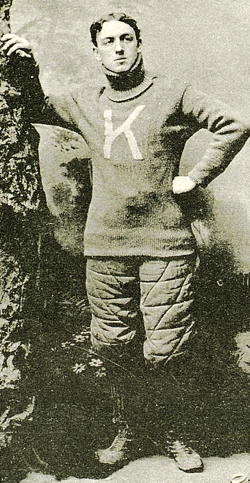 |
Update: Since that time a special football memento of the 1900 season was published on the UK archive site which shows E. Cronley Elliott in his football uniform, and lists him as quarterback of the team (see photo to left).
So the information not only checks out, but based on his graduation date it appears extremely unlikely that Elliott was even still around campus in 1903, eliminating a lapse in memory as to the exact year as a likely possibility. In other words, I haven't found reason to doubt any of Elliott's claims as stated, including that he and others were playing basketball at Kentucky in 1902.
P.S.: According to records, after the article was published Dr. Elliott died the following year in 1962 at the age of 82.
Another update supports the idea that Kentucky students played games during the Spring Semester of 1902. This comes from an article in the February 9, 1902 edition of the Lexington Morning Herald which notes that "The teams will be organized this week. Dates have already been arranged with K.U. and the Lexington Y.M.C.A." The article goes on to provide names of various students who will try out for the team, including Cronley Elliott.
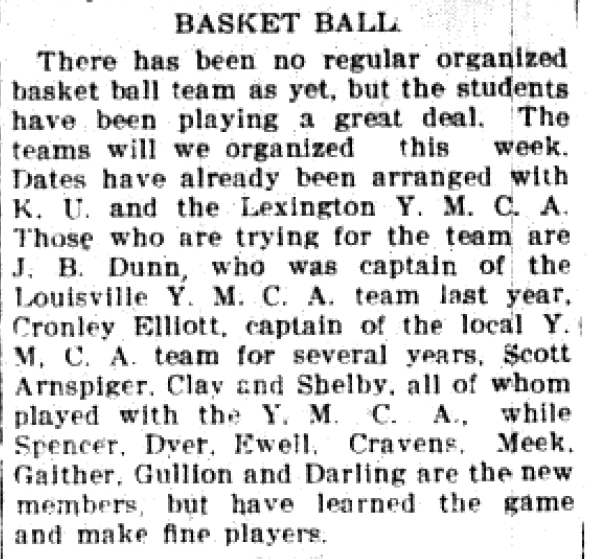 |
None of the players named in the article ended up playing for Kentucky the following season, and it has yet to be confirmed exactly when or if these games took place, beyond the claims made by Dr. Elliott above.
Return to top.
![]()
Dateline February 14, 1908 - Skating through History
As part of going through old microfilm looking for UK boxscores, sometimes you run across things which just tease you. Especially the early part of the century where information is hard to find (if it's even there) and doesn't give a lot of detail. It seems newspapers during those times were formatted a lot differently than they are today or even as they were in the decades to follow.
For example, instead of lengthy articles, the newspapers seemed to be composed of mainly short one or two paragraph snippets about various topics scattered across the page. To make things even more frustrating when trying to locate specific items, the topics were not really organized into identifiable sections as you see today's newspapers. So it wouldn't be surprising to find mention of a basketball game located just about anywhere. Next to a marriage announcement, details of a farm accident or a recipe for an ointment, it doesn't seem to matter where it went.
Anyway, below is a small article I happened to run across while glancing through some microfilm looking for UK games in 1908. From the Friday February 14, 1908 Lexington Leader:
--------------
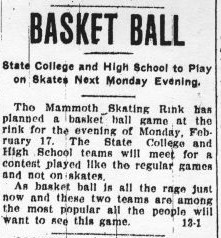
A couple notes from this.
1.) As you might have guessed, there is no official record of such a game played on February 17 in the UK record book. [and no record of State College (UK) playing the high school that year] So if it was played, it would be one which has not been reported to date.
http://www.bigbluehistory.net/bb/Statistics/1907-08.html
2.) Unfortunately from looking at the Monday & Tuesday papers (the day of and day after the game was supposed to be held), there is no mention of it (if it was played at all) at least in the Leader.
3.) Playing on skating rinks apparently wasn't an unheard of thing. Judging from the advertisements of the time, it seems skating was a pretty popular past-time in Kentucky at the turn of the century and it would seem a skating rink would be an ideal place to hold a basketball game, given the crude state of gymnasiums at the time. [I did a quick web search on the history of roller skating and it claims the first practical roller skate was developed by someone in Massachusetts in 1863 and over the next 20 years, it became popular in the US]
Centre College around that time used to play at a place called the Danville Rink. Advertisements for the Rink would mention the game time, and then say that you could skate before and after the contest. And I recently found from a Vanderbilt list that one of Vanderbilt's early gymnasiums (the Hippodrome in Nashville) where they played in the 1930's and early 1940's, was also a roller rink.
FWIW, in the same paper was an advertisement for the Mammoth in Lexington which gives some more information.
---------------------------
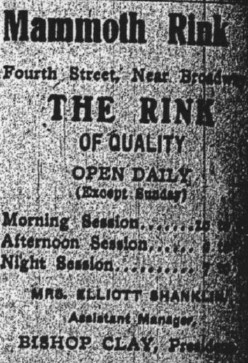
Return to top.
![]()
Dateline January 30, 1917 - The Goat-Boy Strikes !
There's really no good reason to post this story about UK's game against Rose Polytechnic, but hopefully some will enjoy it. The game was unimportant and a blow-out. But I thought I'd mention it anyway because it does strike some interesting visual images and I think is the best I've seen at commenting on the rough play during those times.
Here's the link to the game,
http://www.bigbluehistory.net/bb/Statistics/Games/19170130RosePolytechnic.html
First of all, the beat writer (Tom Underwood) that wrote the game summary is one of the more entertaining UK beat-writers I've seen coming out of the Lexington Herald. If you like the style of this story, I'd suggest reading all his stories from that year. (Be sure to check out future Western coach Ed Diddle's tactics during free throws while he played for Centre a few games prior to this game)
The story also makes any interesting reference to the style of play the Rose squad employed. Back then, most teams kept at least one player back to defend the goal, the back guard. UK even had a player (Ellis Johnson) win all-american honors for his ability to play this position [it couldn't have been for his scoring, he averaged 3.3 points per game in his career] Sometimes the back guard would sneak up near half-court and pop a long shot (the courts were generally much smaller than they are today) but generally stayed back and weren't much of an offensive threat. The Roses instead brought a new method of attack which Underwood thought novel enough to comment on. They brought all five guys onto the offensive end at the same time ! Underwood writes:
"The Roses played a peculiar game that has never been seen before and one has his doubts as to whether it will ever been seen again. Certainly, the Pollies need no copyright or patent or whatever it would take take to keep a team from stealing their style of play. Their method was this. They hugged the Wildcat goal all the time, leaving their own side of the field open. Then when they got the ball they would avalanche down toward the goal en masse. The cataclysm was hard on the Wildcats but it failed to result in many goals. With good team work their efforts might have been more successful."
I found that interesting to see how thoroughly unimpressed Underwood was with this tactic, which although it would take at least another decade (not sure exactly when things changed significantly) would overtake offensive philosophy.
Finally, the story goes into some detail about the rough nature of the game at that time. The goat reference if priceless IMO. I have to wonder what constituted a foul back then ? Incidentally, the referee for that game, was Robert Hinton, coach of the Georgetown team (who had played and beat Rose Poly the night before in a rough game). It sounds strange today but at least at that time, it was not unusual that a coach of another team would be called to referee a game. For example, when Centre and UK played, the Georgetown coach would often officiate. When UK and Georgetown played, the Centre coach would be called to duty. I've seen where former UK coaches would come back the next year and officiate a game, likewise former UK players would be called on to toot the whistle. John DeMoisey (former UK All-American) seems to have been an official for many years after he left UK and called many UK games. (Of course more recently, George Conley (father of UK player Larry) used to officiate games Kentucky played in during the 60's, but that's not quite the same.)
Return to top.
![]()
Dateline January 1918 - Old Man Winter 1, Wildcats 0 or The Curse of the Miami Big Reds
Sometimes things just aren't meant to be. At the beginning of the 1918 season, Kentucky was scheduled to travel by train to Miami (OH) University for a game. They never made it however. Here is the story as published in the Kentucky Kernel, 1/17/1918
---------------
WINTER TRIUMPHS IN KY.-MIAMI GAME
Old King Winter is a cruel old soul as his record shows. besides causing wet feet, cold hands, coal famines, gas shortage, not to speak of waterless dorms and bathless Saturdays, he has been trying his hand at preventing athletics. In the first encounter with the Wildcats, he won.
The squad started in high hopes and modest confidence for the town of Oxford, Ohio, where it was to mete out justice to the Miami University five for their presumptuous contention of a nothing to nothing football score. Things along the railroad were frozen, but Wildcat determination ran high and warm till Winter played his hand. He selected Hamilton, Ohio as the battle field and checked the advance of the Napoleons with one snow. New plans for future games were discussed by the Kentucky coaches and players as they returned home, without any knowledge of Miami's team.
------------------
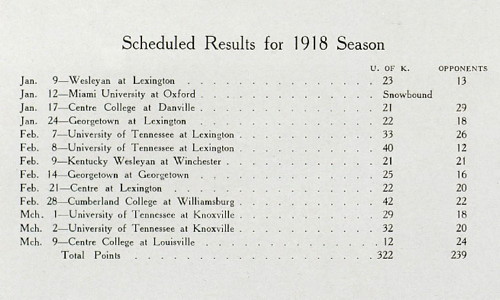 |
The game was never rescheduled for that year. They did play however, the following year. Here is the pregame for that which talks about more hardships in getting these two schools together.
Published 3/16/1919 in the Kentucky Kernel
--------------
MIAMI VS. WILDCATS IS LAST BASKETBALL GAME
In the fall of 1917 football teams representing the University of Kentucky and Miami University fought fiercely to a tie on Stoll Field. In the spring of 1918 the Wildcat basketball team got snowbound, while on its way to Oxford, Oh., and was unable to continue the journey while old Jupiter Pluvius showered his wrath on Stoll field and kept the two teams from meeting in baseball. Flu cancelled the game last fall. But if the world doesn't come to an end first the Big Red Team and Kentucky's Wildcats will meet next Friday night in the last basketball game of the season.
------------
As is turned out, the game wasn't worth the wait for the Wildcats. They were swamped 38-14. :-(
http://www.bigbluehistory.net/bb/Statistics/Games/19190308MiamiOH.html
Return to top.
![]()
Dateline February 26, 1922 - A Fork in the Road
From the February 26, 1922 Lexington Herald:
University of Kentucky is Slated for Invitation to Join Conference Proposed for Middle West Colleges
Chicago, Feb 25. - Steps toward the organization of the central intercollegiate athletic conference for all major sports in the middle West territory were taken at a meeting here today of representatives from a number of non-conference schools in the state comprising the Western Conference.
An organization committee, headed by Coach Knute Rockne, of Notre Dame, and including C.L. Bruce, manager of athletics at Detroit University, was appointed to arrange for a further meeting here March 18, at which final plans for launching the new conference are expected to be formulated. Athletic directors and faculty members of eligible institutions will be invited and all open question anent (?) rules and regulations, schedules and associations will be discussed.
Among the delegates already slated for invitations to the meeting are: Wabash, Michigan Aggies, DePauw, University of Cincinnati, University of Kentucky, Marquette (Milwaukee), Detroit University and Notre Dame. It is probable that other schools will be invited later.
Today's meeting, according to leaders, grew out of a widespread feeling among collegiate athletic officials that conference organization points the only way around the evils of professionalism in amateur sports.
"There is absolutely no question but what athletics would be greatly benefited by such a conference," said Coach Rockne, in an address. "Unless a university is a member of some conference, complying with well defined rules governing eligibility, they come under suspicion, no matter how clean they may try to keep their sports."
The only important rules question left open for the March assembly was that of summer baseball, which was sidetracked today for the opinion of faculty members at the schools involved.
------------
I found this article interesting on a number of levels. For one, the article doesn't mention this but Kentucky was already part of the SIAA (which later became the Southern Conference which later split into the SEC and ACC) at the time. If UK had joined this midwest conference, the entire backdrop would have changed from a Southern university to a midwestern one. I wonder how things would have played out in this scenario in terms of UK building its basketball legacy. This conference would have gone up against the well established Western Conference (which later became known as the Big Ten).
I also found it very interesting and even prophetic Rockne's quotes about how people view teams which don't subject themselves to the rules and regulations of a governing body, seeing how Notre Dame has been one of the biggest holdouts in terms of joining a conference (and remains so today with respect to football).
Return to top.
![]()
Dateline February 9, 1923 - Stung by Cupid's Arrow
published in February 9, 1923 Kentucky Kernel
Freddy Fest is Victim of Cupid's Dart; Marries in Cincinnati
Hero of Many Football Battles Downed by Little God of Love
WEDDING WAS SURPISE
Bride was Childhood Sweetheart of Wildcat Center
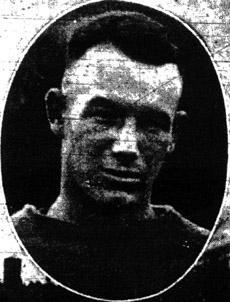 |
| Fred Fest |
Freddy Fest, for three years star on the Wildcat football eleven and bidding fair to annext his first letter in basketball evaded the other members of the squad Monday morning and was married to Miss Mary Harris, of Martins Ferry, Ohio.
Fest kept the marriage a secret until after the game when he refused to return to Lexington with the team and when Coach Buchheit threatened to drop him from the team he announced that there were two for the mentor to consult. Although the basketeers had two more games to play during the week they dropped the cares of the athletic world for the time being and entertained the newlyweds until Coach Buchheit tucked the cagers to bed.
The marriage was the outcome of a childhood romance which began when Freddy and Miss Harris attended the Martins Ferry School. When Fest, who had spent his first year at college at Marietta informed his sweetheart that he was coming to Kentucky to school, she came with him and had been taking the nurse's training course at the Good Samaritan Hospital. Last fall before the football season opened when Fest was operated on for appendicitis, she nursed him through convalescence and it was largely due to her efforts that he was able to take part in the season's schedule.
Mr. and Mrs. Fest returned to Lexington Tuesday night and she will remain for several weeks before returning to Martins Ferry, where she will wait until Freddy is graduated this summer. Fest is a member of the Alpha Sigma Phi fraternity and is a senior in the college of engineering.
-------------
FWIW, Fest, who was the team captain, stayed on for the remainder of the basketball season. Married life must have been good for him as he had two of his best games of his career, a career-high 17 points against Tennessee a day after the above article was published and 14 points against Sewanee in the season finale.
http://www.bigbluehistory.net/bb/Statistics/1922-23.html
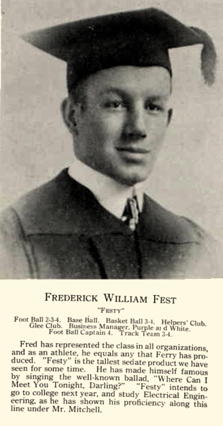 | 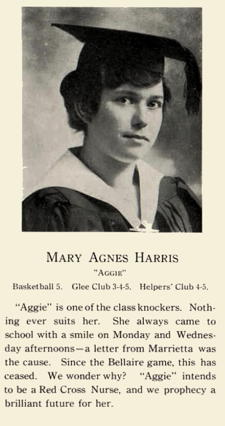 |
1916 Martins Ferry High School | 1917 Martins Ferry High School |
Postscript: According to genealogical records, a son, Fred Fest Jr., was born in Martins Ferry OH in 1924 and the couple eventually moved to West Virginia, settling in Weston. The couple divorced however in 1944. Mary Harris died in 1969 and Fred, who later remarried died in 1974.
Return to top.
![]()
Dateline January 1926 - Scouting Goes High Tech
from the Kentucky Kernel in late January
---------------------
Eklund to Scout Games via Radio
Wildcat Coach Hears Georgia Tech-Georgia Game Through Air
Coach Ray Eklund may use the radio as a means of "scouting" basketball opponents of the Wildcats this season. The account of the game between Georgia Tech and the University of Georgia was heard over the radio by Coach Eklund last Friday, and he was impressed by the clear, vivid manner in which it was broadcast.
Practically all the games in the Southern conference this season will be broadcast, and providing a schedule of all conference opponents of the Kentucky team can be secured, the radio will serve as an accessible and inexpensive means of gaining a line on the various teams.
The games are broadcast play by play, and the account forms, in a sense, a "radiograph" similar to the gridgraph in football. An idea of the team's offensive and defensive styles, as well as of the individual merits of the players can be gained from the radio account, it is stated.
In former years it has been necessary to send scouts to the games in which the opponents of the Wildcats played. This has been a great expense to the athletic association, as the games are often played in cities a great distance from Lexington. It is hoped that the expense incurred by scouts on such trips can be decreased.
![]()
Dateline February 4, 1926 - A Surprise at the Door
On February 4, 1926 was played one of the most unexpected games in UK's history when the Washington & Lee basketball squad (coming all the way from Lexington, Virginia) showed up in the morning at the Athletic Director's door and claimed they had a game against UK that evening. This was news to UK and they had to scramble to put together the match in time. UK went on to win the game. Here is the boxscore.
http://www.bigbluehistory.net/bb/Statistics/Games/19260205WashingtonLee.html
Below is the game summary as written in the Lexington Herald.
------------
Wildcats Come From Behind in Second Half to Beat Washington-Lee, 44-34
KENTUCKY TAKES LEAD ONLY AFTER SUBDUING SPOTTS, NIFTY CENTER
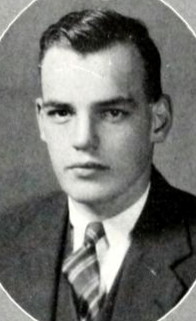 |
The game was a surprise even to officials of the school who hardly knew Washington and Lee had a basketball team until it appeared here yesterday morning, its manager producing a signed contract showing that the game had been arranged for. It was a two-year contract, signed a year ago, which Kentucky authorities had either overlooked or forgotten.
'Cats Put to Bed
Coach Ray Eklund gathered as many of his Wildcats as he could during the afternoon and put them to bed. Meanwhile, Athletic Director S.A. Boles paraded the university band through the streets, to advertise the game. The blare of trumpets did its work and the largest crowd of the season, numbering more than 2,500 persons, was present for the contest.
The game was another thriller, being productive of excellent basketball from both quintets. The Generals took a lead in the first half when Spotts, giant center, slipped in close to the basket to make several crip shots on short passes from his mates.
At one time during the first half, Washington and Lee led by nine points, but the Wildcats began solving the Generals' offense, and with Underwood and Alberts injected into the lineup to break up the visitors' attack, they rallied and the half ended, 22 to 20, in favor of the Virginians.
In the early part of the second half, dazzling floor and good shooting work by Mohney, Jenkins and Underwood sent Kentucky into the lead, 32 to 24, and the Wildcats remained in front for the remainder of the contest, again using their waiting game to advantage.
Kentucky Finds Self
Kentucky appears to have found itself and continued the snappy passing that played havoc with Alabama earlier in the week. Jenkins and Carey contributed a few shots from long range, but the majority of Wildcat field goals were of the crip variety, the ball being worked in to Mohney or Jenkins. Carey's field goal was made from the center circle and was clean as an all-day sucker in the mouth of Little Stanley, the great explorer.
Local fans marveled at Spotts. He was the biggest man on the floor and probably the fastest. All of his field goals were made with one hand and two of them especially were cleverly executed from blind angles. Without Spotts, the Generals would have been weak as a toy balloon. Mohney and Jenkins again led in Kentucky's play, although Underwood, Alberts and Captain Carey did some excellent guarding.
In a preliminary game, Coach Lovell Underwood's University High school five defeated the Danville Deaf and Dumb Institute, 21 to 3. The local five took the lead early and held a decided advantage throughout. Gormley was high point man with 10.
--------------
Return to top.
![]()
Dateline June 28, 1928 - Washed Away
One event that is little known, which potentially affected the history of Kentucky's basketball program happened not in any game, but during the off-season. In the summer of 1928, the city of Lexington endured numerous rainfalls which left the ground saturated with water. On June 28, 1928, a torrential downpour led to flooding throughout the city.
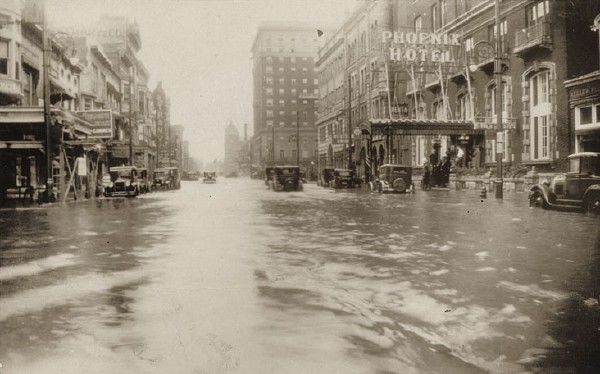 |
Alumni Gymnasium was not immune to the flooding, having been built in a relatively low point near an area of campus which was once a marsh.
Water reportedly reached the playing surface. But more significantly, the basketball offices were housed in the basement of the building, which was completely immersed. Whatever records that had been accumulated on the program to date were completely destroyed. Soon thereafter, Adolph Rupp came onto the scene and completely changed the program's fortunes. What occurred prior to Rupp's arrival was quickly relegated to the far past. Only decades later when Russell Rice began to research UK's history was much of the information on the early years reconstructed. A task made significantly more difficult due to the loss of information that summer of 1928.
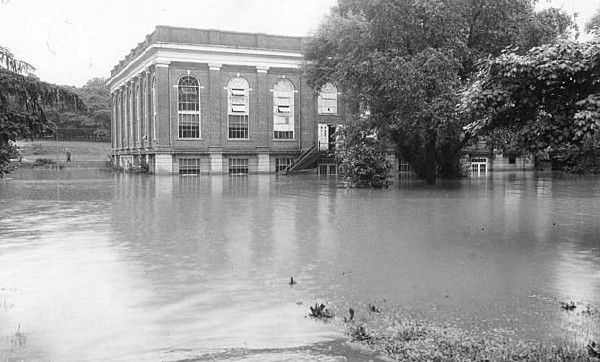 |
Return to top.
![]()
Dateline February 19, 1931 - Positively Perfect
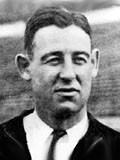 |
An article in the Georgia student newspaper The Red and Black explains the circumstances that found Mehre coaching the hoops squad. According to the article "Mehre, in charge of the Bulldog basketball team in the absence of Coach H.J. Stegeman, directed the Bulldogs in their two victories over Kentucky and Georgia Tech. Coach Stegeman, who helped make football rules in New York last week, resume charge of the Bulldogs Monday, and Coah Mehre tried as a basketball master mind."
The article explained, "When basketball coaches start a fanning bee in the future Mehre can always end the talk. 'That's nothing,' the ex-Notre Dame star can say, 'when I was coaching the Georgia basketball team we never lost a game!'"
Return to top.
![]()
Dateline November 29, 1932 - A Longer Bed
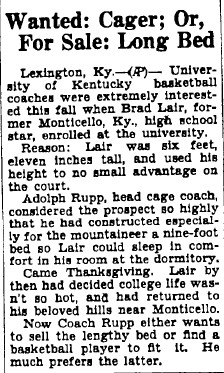 |  | 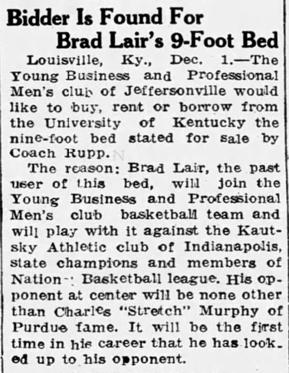 |
The following page was found in a newspaper from 1932 (published in the Sheboygan Press, November 29, 1932), discussing a recruit at Kentucky from Monticello Kentucky. The player was Brad Lair, who was six foot eleven. Originally from Monticello KY, Laird had earlier played one part-season for Jeffersonville IN high school. By early 1932 he was playing for an Independent team based out of Monticello which boasted former collegiate players besides Lair. Lair entered Kentucky in the Fall of 1932 but unfortunately, the player never stayed on campus long enough to play for the Wildcats. This left Adolph Rupp in a quandary as to what to do with the bed he had specially constructed.
A few days later it was reported that Lair had decided to turn professional. The Young Business and Professional Men's Club of Jeffersonville IN announced that Lair was joining their basketball team and expressed interest in purchasing the bed. They were set to play other professional teams such as Indianapolis Kautskys with Charlie "Stretch" Murphy. In later years Lair joined the House of David travelling basketball team.
Return to top.
![]()
Dateline January 6, 1933 - Kentucky's First Action Photo
While action photos of football games were common throughout the 20th century, action photos from basketball games were extremely rare until the late 1930's and 1940's. This may be due to the difficult lighting and limitations of filming indoors with the equipment of the time.
Until recently it was thought that the first action photos of a Kentucky game were taken during the memorable game between UK and New York University in Madison Square Garden on January 5, 1935.
However recently some earlier photos have been discovered, thanks to the fact that more and more collegiate yearbooks have been made available on-line.
The earliest action photo found to date is from Creighton University which hosted two games against Kentucky in January 1933. It's not known whether the photo was taken from the game on January 6, or January 7, but it does clearly show UK All-American Forest "Aggie" Sale (#24) defending agsint the dribbling of Creighton's center Willard Schmidt (#11). Also seen near the top of the photo is another UK All-American John "Frenchy" DeMoisey. A third Kentucky player stumbling back on defense is unidentified.
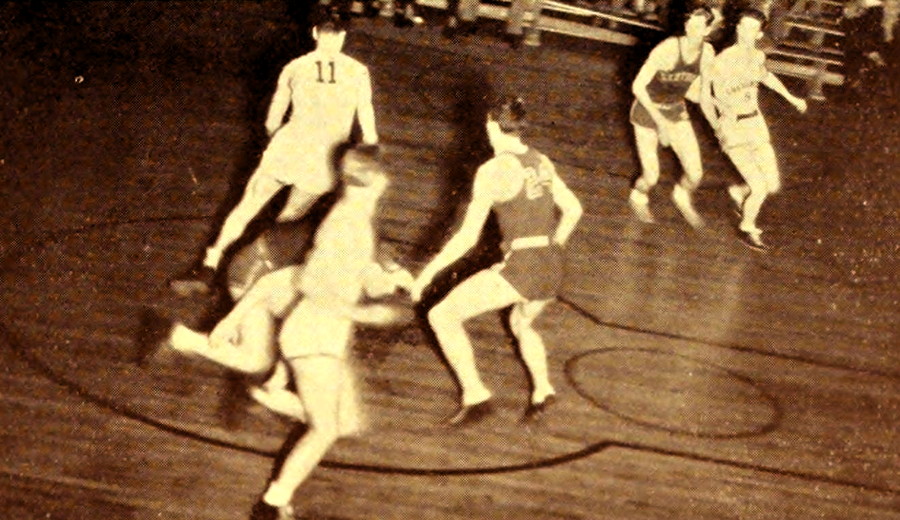 |
Another action photo recently found in a yearbook is from Tulane the following 1933-34 season. This photo shows UK's Andy Anderson grabbing a rebound in front of Tulane's Walter Jahncke (#16). Again this photo may have been from a game December 21, 1933, or the following evening on December 22.
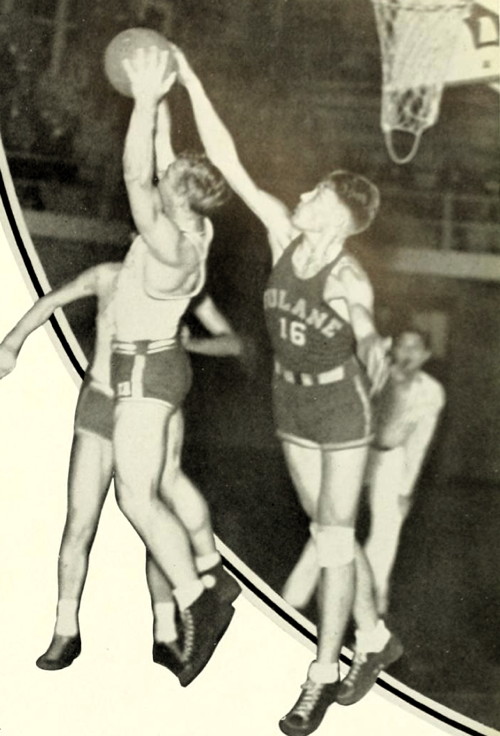 |
Another interesting early photograph was found in the Atlanta Journal during the 1934 Southeastern Conference Tournament held in Atlanta. The photo shows John DeMoisey shooting a layup while being watched by Dave Lawrence.
This photo is noteworthy because it didn't occur during an actual game. It was staged after the Kentucky-Florida game to recreate a shot which occurred during the game. Prior to the contest, the Kentucky players and coaches had agreed to provide the newspaper with an 'action shot' after the game. To their credit they honored their commitment even though the Wildcats had been upset by the Gators moments before.
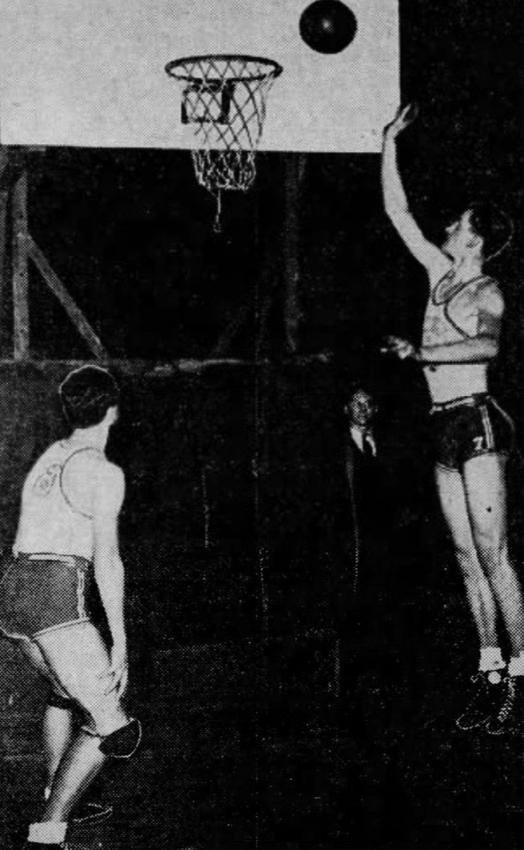 |
It should be noted that there is an even earlier photograph which was found within the Naval Academy yearbook from 1928. The yearbook had a number of action photos from a distance, some of which MAY have been against Kentucky, which played a game in Annapolis on January 18 of that year. But the distance is too far to identify the teams or players.
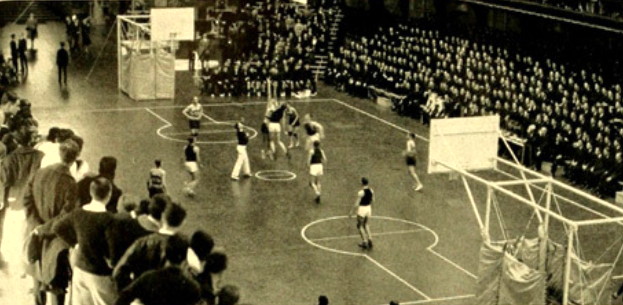 |
Return to top.
![]()
Dateline February 14, 1938 - A Shot from Above
Many I'm sure are familiar with the movie Field of Dreams, where Kevin Costner hears the voice "Build it, and they will come." But did you know that Kentucky has a similar type of story in it's vast history ?
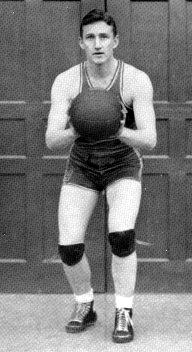 |
| Joe Hagan |
------------
Red Hagan was a lad of destiny last night. He felt it, and so did all those fans who saw Red, a devout Catholic, kneel in the middle of the floor, bless himself, mumble a prayer, and then bless himself again. A few seconds later, Red fired the shot that sent the Marquette Catholics home defeated.
It was in answer to a command that Hagan fired the ball at that precise moment. He said so after the game.
"A voice said to me," declared the battle-flushed Kentuckian, "Shoot Hagan, and it will go through the net. I shot and it went through."
----------
One important thing to note about this shot was that Hagan shot it with plenty of time left on the clock for Marquette to come back and tie the game (unlike, for example Vernon Hatton's shot vs. Temple where he had no choice but to shoot because the time was nearly out.) With his taking such an improbable shot and giving Marquette a chance to score, the odds were running heavily toward him being the goat. In fact, even though Hagan made the shot, Marquette did have multiple chances to at least tie the score, but they failed on each occasion. You can read more about that game at the following link:
http://www.bigbluehistory.net/bb/Statistics/Games/19380214Marquette.html
Return to top.
![]()
Dateline March 4, 1938 - The Greenies Strike
Ran across a game summary from the late 1930's that I found interesting. This UK squad was undefeated in the conference, although they did lose a few out of conference games.
http://www.bigbluehistory.net/bb/Statistics/1937-38.html
What I found interesting was not so much the game itself but a paragraph deep in the text.
---------------
BATON ROUGE, LA. - A field goal by Paul Pare, forward in the final seconds of play, gave Tulane University Greenies a 38 to 36 victory over the favored University of Kentucky Wildcats tonight in the final second round game of the annual Southeastern Conference basketball tournament here tonight.
It was the first upset of the first and second rounds of play in the tournament. For Tulane it was its second triumph of the day for in an afternoon game only a few hours earlier the Greenies had put the University of Georgia out of the running.
....
Tulane would never let loose of the Wildcats and Pare's field goal from the foul line in the last few seconds broke a 36 to 36 deadlock and blasted Kentucky out of the tournament. The Wildcats were the defending champions and highly favored to win the title again this year, but tonight wasn't their night. The cards were stacked against them. The defeat probably cost them a trip to New York to play in a intercollegiate tournament for eight of the nation's outstanding basketball teams as the Cats were to be invited tonight.
-----------
For those who didn't catch it, that tournament UK missed was the inaugural National Invitational Tournament, which predated the NCAA Tournament by one year. In those early days, the field consisted of 2 local New York teams, 2 Eastern teams and 2 from the Midwest or Far West. That particular field included NYU and Long Island, Temple and Bradley (presumably this counted as an Eastern team ?) along with Oklahoma A & M and Colorado. Temple won that tournament.
Return to top.
![]()
Dateline January 21, 1939 - A Familiar Face Returns
With the impending arrival of Rick Pitino in Lexington to coach a game against the Big Blue and all the hub-bub that's going to (and already has) create. Some may not know that this is NOT the first time a former head coach at UK came back to coach against his former team. It's happened before.
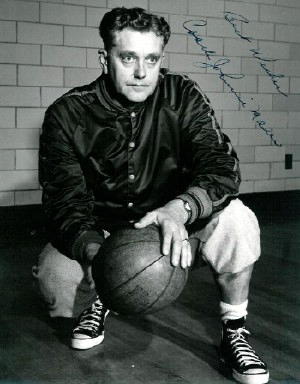 |
| John Mauer |
So I thought it appropriate to mention what happened when Mauer returned to Lexington for the first time. Here's some snippets from the (admittedly tame) pre-game story by the Lexington Herald's Ed Ashford:
----------------------
Coach Adolph Rupp's University of Kentucky Wildcats will make their Southeastern Conference debut tonight at the University gymnasium with Coach Johnny Mauer's Tennessee Volunteers furnishing the opposition. The tilt will start at 8 o'clock.
...
Coach Rupp has been working his boys hard all week and is expecting the Tennessee team to furnish plenty of opposition tonight. Last year the Volunteers gave the Wildcats more trouble than any other conference team met during the regular season and this year playing their first season under Mauer, who preceded Rupp at the University of Kentucky, the Volunteers apparently have just hit their stride. Wednesday night, Mauer's team annihilated Sewanee's Tigers, 51 to 27 for their first Big 13 triumph of the season.
....
This will be the first time that a Rupp-coached team will meet one tutored by Mauer and the fans will have an opportunity to compare Rupp's style of play with that used by the erstwhile Kentucky mentor. Mauer, after leaving here, coached at Miami University at Oxford, Ohio, until last fall when he was signed by Tennessee to replace Blair Gullion, when the latter accepted a post at Cornell.
-------------------------
Perhaps a bad omen, but Kentucky played poorly that game and Tennessee was able to escape with an upset on UK's home-court. Here's the boxscore and game writeup.
http://www.bigbluehistory.net/bb/Statistics/Games/19390121Tennessee.html
In fact, of the first 15 games played between Mauer and Rupp, Mauer held his own with a 7-8 record. This included two UK losses in the SEC tournament championship game. I wouldn't like to see how UK fans would handle a similar scenario with "Traitor" Rick ?
Return to top.
![]()
Dateline December 21, 1939 - We're Here, Where's the Gym ?
The city of Asheville NC was looking to open a newly built Municipal Auditorium in the winter of 1939. The building, constructed at a cost of nearly $250,000, was paid for by donations from the local community along with money from the city and grants from the Public Works Administration. The land for the auditorium was donated, and sat next to the existing Vanderbilt hotel.
The 1939 conference champions of the Southern Conference (Clemson) and the Southeastern Conference (Kentucky) were invited to Asheville to inaugurate the newly built arena.
The game was held December 21 of 1939. The only problem is that the newly built auditorium was not yet ready. An alternative gymnasium was used for the event, that of the American Enka Corporation which a Dutch-based textile company located in nearby Enka. The Enka gymnasium had been built a few years earlier in April of 1937.
The game went on and Kentucky won a convincing 55-31 victory. The Asheville Municipal Auditorium was opened a few weeks later, although Kentucky never got to play in it, and in fact has never returned to the city.
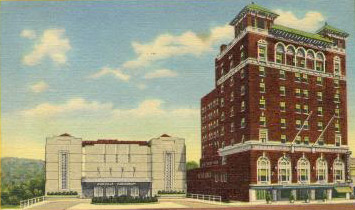 |
| Asheville Auditorium next to the Vanderbilt Hotel |
Return to top.
![]()
Dateline January 7, 1940 - Donkey Basketball at its finest
From the January 7, 1940 Lexington Herald
Braying Battles Are Promised in Donkey Basketball Games
Basketball's version of "Three Men on a Horse" will be staged in the U.K. Alumni gym Wednesday and Thursday nights when Lexington athletes mount rubber-shod donkeys and plod forth to braying frays on Wildcat hardwood.
Jackass basketball, a comparatively new recreation, is played with a regulation pellet, has special rules and shorter periods than the homo sapiens variety. Passing and shooting are executed while players are astride their burros and penalty shots are awarded when a member dismounts for any reason other than retrieving the ball from the floor.
Double-headers are scheduled for Wednesday and Thursday nights. First twin-bill sends the University coaching staff quintet spurring against a chosen five from the U.K. faculty, a squad that should feel strange riding something besides the students. The nightcap pits Wildcat football backs against a team composed of linemen.
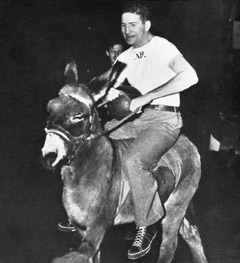 |
| Ab Kirwan |
Sponsors of the burlesque are the "K" club, Kentucky varsity lettermen and Omicron Delta Kappa, campus honorary leaders coterie. Adults' tariff is 40 cents, childrens' 25 cents. Both hoop rodeos start at 8 p.m.
The equine proletarians to be ridden during the gallops are supplied by Ralph Godfrey's Crescent Okla. ranch.
The respective squads follow:
UK Coaches - Ab Kirwan, Bernie Shively, Frank Moseley, Gene Myers, Joe Rupert, Joe Huddleston, Lloyd Ramsey, Paul McBrayer and Adolph Rupp. Coach - S.A. (Daddy) Boles; trainer - Frank (Skipper) Mann; manager - Buster Brown; cheer leader - Mrs. Greenwood Coconaugher
Junior Chamber of Commerce - Richard Bush, Joe Arnold, Carryl Britt, Leonard Cox, Louis Brock, Walter Hillenmeyer, Louis Hillenmeyer, Garvice Kinkead, Speedy Wilson and Ed Houlihan. Coach - Paul Nickell.
Optimist Club - Louis Ades, Nathan Elliott, Paul Mansfield, Waller Jones, Petey Powell, Ted Hardwick, O.A. Bakhaus, Bernie Shively, Ab Kirwan, Frank Moseley, Willis Haley and Dod Dodson. Coach - Emmet Milward, manager - Felix Kennedy; team physician - Dr. C.G. McLean; trainer - Ballard Woods; veterinarian - Dr. S.S. Parks
-----------
Return to top.
![]()
Dateline - March 14, 1942 - A Game Played for a Cause
March 1942, the United States was getting back on its feet and preparing for a long war, having just weathered a surprise attack by the Japanese at Pearl Harbor a few months before and declaring war on enemies on each side. To help with the effort, a game was scheduled between Kentucky and the Great Lakes Naval Station in Louisville to raise funds for the Navy Relief Society.
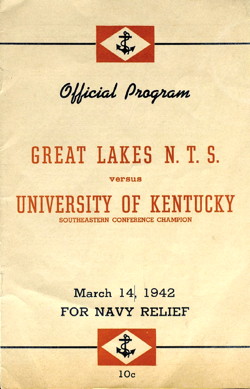 |
| Program from the Game |
https://www.ntcgl.navy.mil/history/1943football.html
The teams put together by the Naval Station during the second world war was literally a who's who of former college basketball players prior to the war. The team UK faced in 1942 had no less than six former All-Americans, including Lee Huber who had been an All-American at Kentucky under coach Adolph Rupp. The others were "Junie" Andres and Bill Menke (Indiana U), Frank Baumholtz (Ohio U), Bob Calihan (Detroit) and Dick Klein (Northwestern)
http://www.bigbluehistory.net/bb/Statistics/Games/19420314GreatLakes.html
Also on that team was Forrest (Forddy) Anderson of Stanford who went on to be a well-respected coach at Bradley and Michigan State.
UK facing 6 players who held All-American status may well be a record. One team which may give them a run for their money is the Great Lakes team of the following year.
That team again featured Dick Klein but also had former All-Americans Ed Riska (Notre Dame) Bob Davies (Seton Hall) George "the blind bomber" Glamack (North Carolina), Forrest Sprowl (Purdue) and Gilbert Huffman (Tennessee).
http://www.bigbluehistory.net/bb/Statistics/Games/19430306GreatLakes.html
Return to top.
![]()
Dateline - January 24, 1943 - Recruiting them Young
Warning: This message only has a very slight link to UK. It talks about former Notre Dame coach Elmer Ripley and some of his players (which included ND player Billy Hassett) and was IMO quite an amazing story. I ran across this article, and having recently written the series history between Notre Dame and UK recognized the names.
As an aside, Hassett played for Ripley when Notre Dame played UK in 1946
http://www.bigbluehistory.net/bb/Statistics/Games/19460126NotreDame.html
and earlier played against UK while Clem Crowe was the coach at Notre Dame.
http://www.bigbluehistory.net/bb/Statistics/Games/19450127NotreDame.html
If you read the series history, you might remember that after George Keogan died in the early 1940's, Notre Dame went through a string of coaches.
http://www.bigbluehistory.net/bb/rivalNotreDame.html
Anyway, this article doesn't deal with Notre Dame or UK at all, but with what happened prior to that when Hassett and Ripley were at Georgetown in Washington DC. From the Lexington Herald-Leader in 1943.
-------------------
WASHINGTON, D.C. Jan. 23 (AP) - Just as a joke, Elmer Ripley pitted a team of 11-year-old New York youngsters against Temple University's famed championship five at a basketball clinic in Madison Square Garden. The purpose was to demonstrate Temple's zone defense, which had baffled the best collegiate teams.
What Rip saw made him gasp. The kids passed the ball in, around and through the zone and scored with monotonous regularity. And Temple wasn't fooling.
That was some eight years ago, and Ripley's kept tabs on the kids ever since. When he left Yale, and moved to Georgetown as basketball coach, Ripley sold the young men the merits of higher education at Georgetown.
So today the rare combination of youth and experience is blended in the all-sophomore Georgetown five, a fact which qualifies the Hoyas as one of the two youngest quints in the East.
There's that combination of Danny Kraus and Billy Hassett as breathing proof of the success of the metamorphosis. Rip says Kraus is "the kind of a ball player who makes a team click." Danny, all-New York City selection in the 1939-40 and 1940-41 seasons while at DeWitt Clinton High, was incapacitated much of his freshman season by a bad knee, but he's in his old form now.
Hassett, a neighbor of Kraus in the Bronx, served his basketball apprenticeship at LaSalle Military Academy, Oakdale, Long Island, where he played baseball in addition to basketball. He was named the most valuable player in the 1940 Eastern State tournament at Glens Falls, N.Y.; in 1941 he was named on the all-Eastern team.
And there are many others of the same ilk on the hand-picked squad, many of them the same 11-year-olds who fooled Temple that night. Most are from New York and New Jersey, and all of them are top cream - guys like Lloyd Potilicchio, Don Gabbianelli and Meggs Reilly, to mention a few.
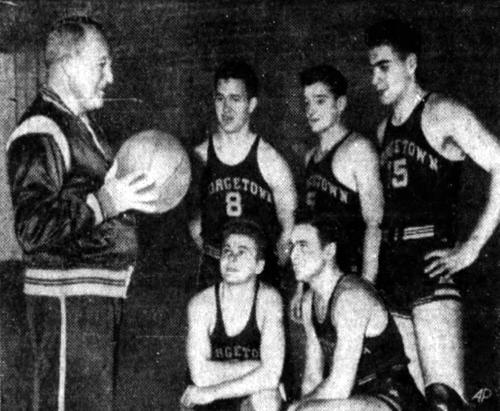 |
A couple things I found noteworthy, beyond the main fact that these schoolboys ended up playing for and succeeding with Ripley.
1.) Hassett left Georgetown and ended up at Notre Dame (transfers during WWII era were not uncommon) where he eventually ended up playing for the same coach he played for at Georgetown. How many times does something like that happen ?
2.) Hassett was named All-American during his career and that 1943 Georgetown team actually made it to the NCAA Championship final, where they got beat by Wyoming. I'm sure most people assume Georgetown had little noteworthy basketball accomplishments before John Thompson took over.
3.) I found it interesting that Temple was renowned for their zone defense. Another case of the more things change, the more they stay the same !
FWIW, I sent that article to a guy who runs a very good historical website devoted to Georgetown and he wasn't aware of the story, even though he's written a short (but interesting) history of the Georgetown program.
http://www.hoyabasketball.com/narrative.htm
Return to top.
![]()
Dateline January 1, 1945 - Quizzing the Kitty
from the Lexington Herald, January 1, 1945 while UK was in New York City playing Clair Bee's Long Island Blackbirds after winning a squeaker over Temple in Philadelphia a few nights before and Wyoming before that (in Buffalo NY of all places).
------------
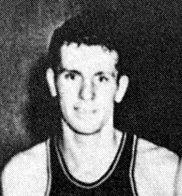 |
| Wilbur Schu |
The Cats filled their jeans at the quiz show when Phil Baker, the master of ceremonies, decided to double the usual $64 award for the last question.
Kenton (Dutch) Campbell, second-string center from Newark Ohio, was called out of the audience to read the questions after Schu had stated the team's business in New York, and the audience was rooting for the Wildcats all the way.
After Schu had given all of the answers correctly, Baker announced that each of the two Kentucky participants would receive $64. Schu and Campbell then announced they would split the money with their teammates.
The Herald received numerous telephone calls from Lexingtonians who heard the broadcast.
-------------
Return to top.
![]()
Dateline February 28, 1947 - Sometimes you have to leave some behind
from the February 28, 1947 Louisville Courier Journal:
by Roy Steinfort, Courier-Journal Staff Writer
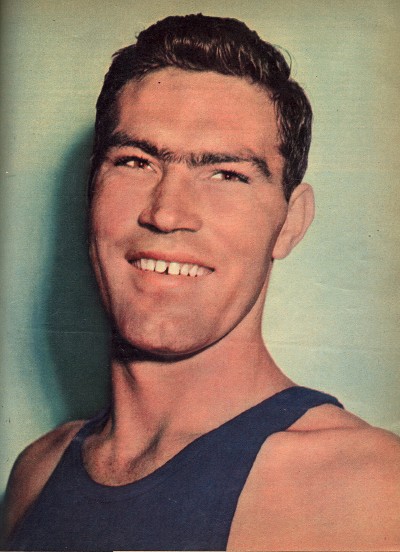 |
| Bob Brannum |
In an eleventh-hour decision, the Baron from the Bluegrass decided to sacrifice rangy six-foot five-inch Brannum and lanky six-foot three-inch Jordan.
"We'll need speed, not height to win this affair," Rupp announced in making his final selections.
Two freshmen, of all people - green as grass in collegiate basketball circles - were nominated by Rupp to fill in for the two displaced All-Americans.
Jim Line, southpaw shooting first-year man, and Dale Barnstable, yearling from Antioch, Ill., were the two players Rupp selected less than two hours before last night's game.
And Line wasn't a bad choice. He collected 20 points against Vanderbilt - which isn't bad for a freshman.
Jordan, twice an All-American at North Carolina as a Navy V-12 student during the war, has never measured up to Kentucky's standards for fast-breaking firehouse basketball.
Brannum early this season was used as a first line replacement for regular pivoter Alex Groza, currently Kentucky's leading scorer.
NO MERCY
Both Brannum and Jordan displayed obvious disappointment in not being selected for the coveted tournament assignment.
"We have to agree with the coach," Jordan sadly said last night as he observed his teammates massacre Vanderbilt.
Brannum smiled and said, "There's really not much I can say, is there ?"
As expected - and predicted - Adolph Rupp, or his Kentucky Wildcats, didn't take any mercy on an undermanned Vanderbilt team.
Rupp several weeks ago proposed to his S.E.C. colleagues that the tournament squad be raised from the present 10-man limit to 12 players.
But the rivals - probably because Rupp first suggested it - voted the proposal down seven to five.
Vanderbilt's Coach Norman Cooper was one who voted against the idea. After a fashion, Rupp early this week privately indicated that he was coming to Louisville to unleash his team's great offensive power.
Vandy's Cooper knew what he was in for before the game. After the affair got rolling good - and his boys were behind by 40 points - Cooper pulled out a cigar, applied some fire and relaxed.
The inevitable was happening. And there wasn't much he could do about it.
After it was over, Cooper said: "I've seen Kentucky hot, but this exhibition tops them all. There wasn't much Rupp could do, he only had 10 players."
----------------------
Postscript - Kentucky went on to win the SEC Tournament that year by following their Vanderbilt victory by beating Auburn (84-18), Georgia Tech (75-53) and Tulane (55-38), despite Alex Groza being less than effective with a lame back. Kentucky went on to participate in the NIT that year, but Brannum was again missing from the traveling squad as he had decided to transfer to Michigan State. The following year, Brannum and the Spartans nearly upset Kentucky's Fabulous Five in a packed Jenison Fieldhouse. Brannum went on to play six years in the NBA.
Return to top.
![]()
Dateline December 30, 1950 - In Remembrance of a (Chump)ion
In December of 1950, the Herald ran a short article talking a little bit about this inglorious season in UK history. (along with a team photo which I haven't seen anywhere else)
So in the name of remembering the good with the bad when it comes to UK's history, here's the article.
Fans Little Remember (Or Care To) The Season When UK Cagers Won Only Three of 16 Games
By Lewis Donohew
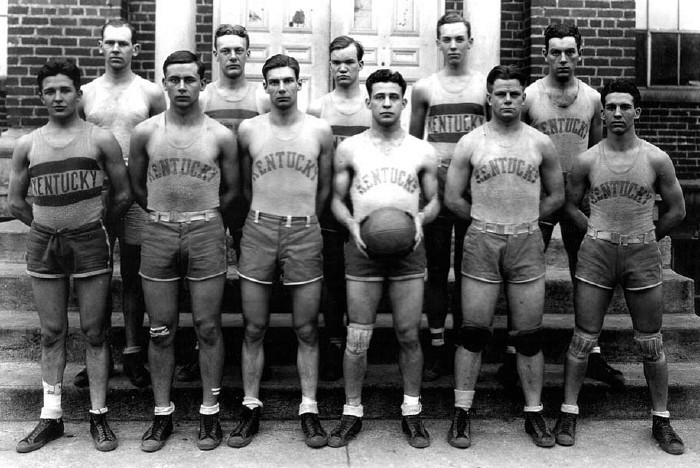 |
ILL-FATED BASKETEERS -- The Kentucky Wildcats of 1926-27 (pictured above) were an ill-fated team, found the going rough from start to finish and won only three contest over a full-season schedule of 16 games. The team members were, left to right, front row -- Jimmy Sharpe, Claire Dees, C. Foster Helm, Capt. Paul Jenkins, Frank Phipps and Edwin Knadler; second row -- Coach Basil Hayden (All-America at Kentucky in 1921), Ferdinand Wieman, Egbert Marshall, Bill Heizer and Bill Ropke. |
Nowadays when the University of Kentucky basketball team romps through a season -- winning nine-tenths of its games over big time opponents -- and then breezes through a national tournament, not even the most rabid fan will lift a eyebrow in surprise.
It is no more than is expected of the famous basketeers.
But how many fans can recall the days when basketball prospects weren't so bright. How many can remember the year in the Alumni gym era that the Cats won only three games during an entire season. That's right - just three victories out of a full schedule of 16 contests. The mark was posted in 1926-27 during the third year of play in the school's fine new Alumni gymnasium.
On Dec. 9 of this year Memorial Coliseum was dedicated to athletics at Kentucky and the veteran Alumni gym was presented with a plaque, commemorating the great record of the Wildcats during their stay there - 478 wins against 114 losses, including the three-victory season.
Centre Beaten Twice
Two of the Kentucky triumphs that year were over Centre. The Colonels were the No. 1 rivals in those days and the wins were appreciated about as much as a football victory over Tennessee would be today.
"Back then if we beat Centre all other losses were forgiven," reminisced S.A. (Daddy) Boles, athletic director during the '26-'27 season and now veterans' housing projects manager at UK.
"Other than that, I don't remember the season too well," said Boles, "except that it was a good year to forget."
The Cats were ill-fated from the start that year. They lost their coach because of illness a short time before the season opened and Basil Hayden, All-American Forward at Kentucky in 1921, had to jump in to take over the coaching duties. The Kentucky team dropped four straight games before settling down to whip Florida, 44-36 for its first triumph.
Then came the first big game with Centre. The Colonels came into town with all the confidence and audacity in the world. Their football team had slaughtered the Wildcats in the fall and here was the chance to make it a clean sweep.
Kentucky won, 27-25, on a field goal by Forward Edwin (Toots) Knadler just as the game-ending whistle sounded, after Knadler had given the Cats their tying points on a crip shot a few seconds earlier.
The Kentucky Kernel, UK's student newspaper, commented after the game "In many respects athletics at the University this year have been disheartening. But when the basketball team wins its most important game when even its staunchest supporters doubted its ability to do so and in such a glorious manner as the Centre game was won, the future takes on a rosier aspect."
Maybe it seemed rosy then, but it did not stay that way long. The Wildcats played the rest of the season without winning a single game, other than their second victory over Centre, to become the most ill-faring team in modern Wildcat history (since the beginning of the Alumni gym era in 1924).
At that time Kentucky was a member of the Southern Conference. A little while before the end of the season the Cats were informed that if they won two more games they would be invited to the conference tournament. But they couldn't quite get up that extra push to put them in the victory column again.
After the season the Kernel editorial writer said "The entire student body knows the situation. For the first time Kentucky has not been invited to attend the Southern Conference tourney. The Blue and white basketeers, following in the wake of their football brothers sufferd the worst season in many many years."
Only two times did Kentucky cagers ever win less games and those were on the abbreviated schedules of 1904-05 and 1906-07 when they turned in 1-1 and 2-4 records, respectively.
At the athletic banquet following the end of the season Boles said "Just the determination to win games is not everything in athletic contests. The question of honor is the most important thing at stake and I can say with great appreciation that this year's team was as clean a bunch of players as I have ever seen."
And there you have it. The mark of that years seems almost unbelievable when compared to that of the present-day Wildcats, who hold a record of 416 wins and 77 losses under Coach Adolph Rupp, in the last two decades who have played in fifteen national tournaments and who have an overall tournament record (including the Southeastern) of 72 victories against 16 defeats.
But every team has some years that, as Boles said, it would like to forget. And when Kentucky followers get together the '26-'27 season is the one that is not mentioned in polite conversation.
-------------
Return to top.
![]()
Dateline March 21, 1952 - Pulling Back the Welcome Mat
Some may have seen that in the 1952 NCAA Tournament, No. 1 ranked Kentucky got beat by No. 10 St. John's in Raleigh, at the North Carolina State's Reynolds Coliseum.
http://www.bigbluehistory.net/bb/Statistics/Games/19520322StJohns.html
This was a huge upset, as earlier in the year, Kentucky hosted St. Johns in Lexington and won the game convincingly 81-40.
http://www.bigbluehistory.net/bb/Statistics/Games/19511217StJohns.html
According to Tev Laudeman's book, The Rupp Years
----------
St. John's didn't figure to be much trouble the next night. After all UK, which had improved steadily as the season progressed to finish No. 1 in the polls, had polished off the New York team easily back in December.
The UK players got the idea that St. John's players expected to lose. Both teams stayed in the same North Carolina State dormitory, and UK players suspected that some of the St. John's team had drunk a few beers. They could hear the St. John's players laughing and yelling and having water fights well past a normal curfew.
The next night St. John's beat UK 64-57. Bob Zawoluk, the 6-7 center who always had so much trouble scoring against [Bill] Spivey, tallied 32 points and Jack McMahon (later a pro coach with Kansas City, Chicago, Cincinnati San Diego and Pittsburgh) scored 18. [Cliff] Hagan scored 22 points, but he, Billy Evans and Lou Tsioropoulos fouled out.
St. John's coach Frank McGuire apparently didn't know about his team's casual attitude of the night before. "Our boys hadn't forgotten that game (at Lexington in December) and were determined to make up for it." he said.
-----------
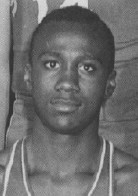 |
| Solly Walker |
Ashford wrote:
Those in the know say that the real reason the teams are quartered in NC State dormitories here instead of hotels is because no Raleigh hotel would accept Negroes as guests. There are Negro players on both the Penn State and St. Johns squads.
------------
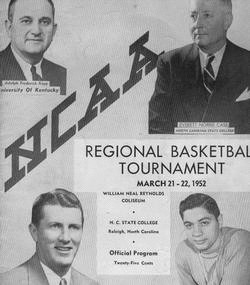 |
| Program |
In McGuire's book, Frank McGuire - The Life and Times of a Legend, it mentions a part of this episode in history although it doesn't mention the dormitories at all (which actually leads to questions whether the black players even stayed in the dormitories or not). [I should mention that McGuire's recollections don't always square with other information I find from other sources.]
Ultimately, Walker and two black players from Penn State
were put up by some local Catholic priests who were friends
of McGuire's.
--------------
Return to top.
![]()
Dateline December 12, 1953 - Somethin' Just ain't Right
It looked like just your typical thrashing of the Xavier Musketeers by the Kentucky Wildcats. Frank Ramsey scored 27 points and Kentucky won the game going away 81-66.
http://www.bigbluehistory.net/bb/Statistics/Games/19531212Xavier.html
Typical except for one detail which postponed the game for a number of minutes. According to Ed Ashford's column in the Lexington Herald-Leader:
"The start of the game was held up 15 minutes when [Adolph] Rupp's eagle eye detected that the goals were too far away from the foul lines. A tape measure was called for and it was discovered the goals had been set 16 feet from the foul line instead of 15 feet.
According to veteran [Cincinnati] Garden sports observers, the goals had been set in that manner for the last three years, but no one noticed it until tonight. It took several minutes for the Garden attendants to move them to the correct spot."
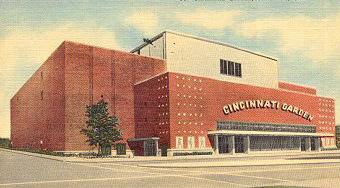 |
| Cincinnati Gardens |
JPS Note: In an interview in the 1970's, Rupp mentioned the incident and gave Cliff Hagan full credit for noticing the goals were not set properly.
Return to top.
![]()
Dateline December 18, 1960 - Grounded
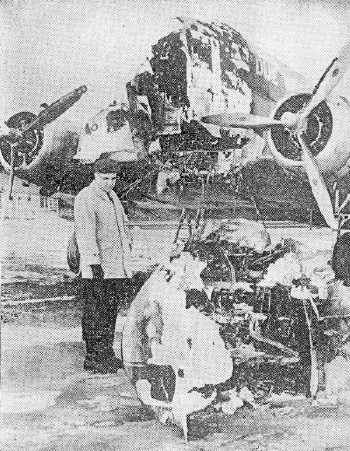 |
The Kentucky contingent arrived at the Philadephia Airport in two cars to board a chartered flight back home. However as the first car pulled up to the tarmac, they found the plane they were to board was on-fire. Only the pilot and co-pilot were aboard at the time and luckily they escaped without harm.
It turned out that the planes batteries had been charged as part of the pre-flight preparations, however after the battery connections were removed, the charging equipment was inadvertendly left in place. When the plane began to taxi to another position, it ran over the equipment and the fire was started, which eventually resulted in the nose of the aircraft burning off.
After much work, and assistance from the athletic director, a new flight for the entire party was arranged. Just as the team was finally settled in, an announcement came over the PA system that "Passenger Lickert" had to leave the plane to make room for another passenger with a guaranteed seat. Upon hearing this, another passenger on the flight recognized that "Passenger Lickert" was UK star Bill Lickert and graciously he offered his seat, opting to take a later flight.
The team finally arrived back at Bluegrass Field later in the day, later than they expected but thankful to be back home.
Return to top.
![]()
Dateline March 19, 1966 - Not a whole lot new under the sun
Included in the aftermath of UK's loss to Texas Western in the 1966 National Championship game, Lexington Herald Sports Editor Billy Thompson wrote a couple of snippets in his 'Pressbox Pickups' column concerning the earlier game with Duke.
http://www.bigbluehistory.net/bb/Statistics/Games/19660318Duke.html
You can file these under 'these sound familiar, haven't I seen these recently ?' So much for originality !
From the March 20th, 1966 Lexington Herald.
...
Banners around the fieldhouse at College Park were numerous. The Duke contingent had a big winner which read: 'We're only No. 2 so we try harder.'
Return to top.
![]()
Dateline April 28, 1966 - Be Careful of First Impressions
Dan Issel of Batavia IL is the all-time leading (men's) scorer at the University of Kentucky with 2,138 points. And he went on to an outstanding ABA and NBA career, scoring 27,482 points and was inducted into the Naismith Basketball Hall of Fame in 1993.
But Issel almost didn't end up at Kentucky, and it can all be traced to a rather innocuous excerpt from the student newspaper.
According to an excerpt in Tev Laudemann's book The Rupp Years (1972):
"Issel finished with a 33.9 scoring average and a career total of 2,138 points. All this from a player who was third choice on UK's shopping list in 1966. Issel, who twice had been an All-State and All-America high school player at Batavia, Ill., got a message fast when he visited the UK campus. He picked up a copy of the school newspaper, the Kentucky Kernel. There was a story in it about the recruiting campaign being waged by UK assistant coach Joe Hall. There were players mentioned at every position, including two centers. There were the name of Mike Casey, Jim Dinwiddie, Randy Pool and Terry Mills. Nowhere did Dan find his name. 'I couldn't help but feel I wasn't No. 1,' Issel said later. He went home and signed with Wisconsin. After UK failed to sign the two other centers on its list, Hall renewed efforts to land Issel." |
While this makes for an interesting story, searching through the Kentucky Kernel archives it's not clear that Issel was necessarily the third choice.
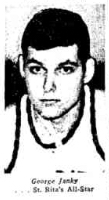 |
Based on the description in Laudemann's book, what Issel likely saw on his visit and is referring to was an article written a few weeks earlier in the Kernel ("Top Alabama Basketballer Signs Grant with Wildcats", Kentucky Kernel April 5, 1966.) which did mention that big men recruits Janky and Bergman were scheduled to visit UK in the near future. The article only mentioned Janky and Bergman, although it didn't explicitly say these two were the top two, or only recruits at the position.
 | 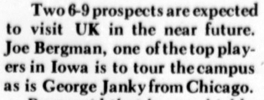 |
After Issel's campus visit, an article published on April 28 noted that one scholarship opening remained available for one of the three big men possibilities, along with guard Rick Mount of Lebanon IN who might be too talented to pass up. (Mount ended up at Purdue where he was a prolific scorer, ending up as Purdue's all-time leader.)
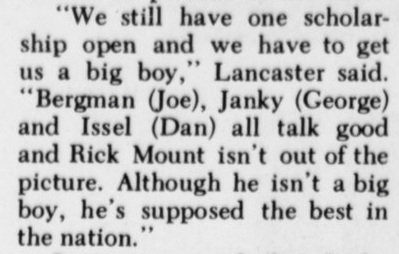 |
This third article lists Janky, Bergman and Issel, and while Issel is mentioned third, the article indicates that the lone remaining position was still up for grabs.
It is noteworthy that in his book Joe. B. Hall - My Own Kentucky Home that Hall gives specific information about the recruitment of these players which gives some insight into UK's preference. Noted Hall:
| The need for a good, big man was evident. The top center prospects in the nation that year were Joe Bergman of Iowa, George Janke of Dayton (sic), and Dan Issel of Batavia, Illinois. Each signed with other universities, but Joe B. refused to give up. "We recruited Janke and Issel hard," he said, "then we concentrated on Issel."
Issel would say later that during a visit to Lexington he picked up the school newspaper and failed to find his name mentioned in a story about basketball recruiting. "I could not help but feel that I wasn't number one," he said, "so I went home and signed with Wisconsin." Issel's father, who had wanted his son to sign with Northwestern, convinced the prep All-American to visit UK one more time. Airport manager Logan Gray rolled out the red carpet and the city gave Issel a rousing welcome. He signed with the Wildcats. |
As it turned out, Bergman signed with Iowa but after his freshman season transferred to Creighton to finish his collegiate career. Janke signed with Dayton where he faced Kentucky in a UKIT game in 1967 (outscoring Issel 19-13).
While all three players were drafted after college, only Issel played in the NBA.
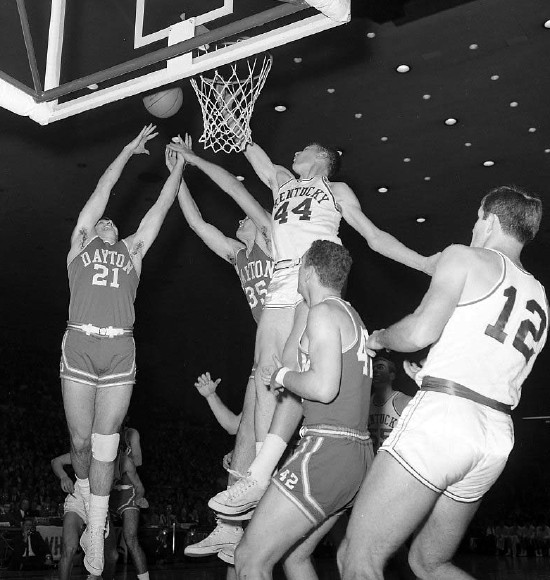 |
Return to top.
![]()
Dateline January 1969 - The Race for 1,000 Victories
As the 1968-69 Season progressed, the 1,000 Victory mark came down to a three-way race between the University of Kentucky, Kansas, and Oregon State. These teams had been vying for the top spot in all-time victories since the early 1960's when Kentucky put themselves in contention and challenged for the lead. The teams were in a neck-and-neck race for the lead for a number of seasons.
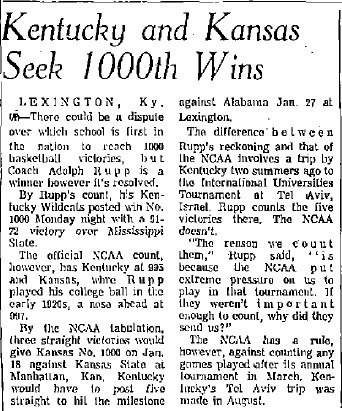 |
The dispute originated in 1966 after Kentucky's National Runners-up Season where the team was invited to the World University Games, held in Tel Aviv Israel. Kentucky entered the international competition against university teams from around the world and won the event, going 5-0.
Kentucky coach Adolph Rupp considered the games to be legitimate victories to add to both Kentucky's and his own all-time record, especially considering that UK was representing the United States at the NCAA's urging. "If they (the games) weren't important enough to count, why did they send us!" asked Rupp. The NCAA was petitioned to update their records to account for the games, but they never did so. (Soon after Rupp's claim was made public, Oregon State (who were struggling that year, and were already out of the 1000-win race) noted that they had already eclipsed the 1000-victory mark with 27 victories during an international tour of Australia in 1967. The Beavers too were turned down by the NCAA however.)
Rupp was winding down a career which saw him break records, and with each record there was now a difference of five games between what Kentucky recognized and what the NCAA did. On January 6, 1969, Kentucky beat Mississippi State in Starkville and celebrated what they considered to be a historic milestone. They ate a small cake at their hotel room to mark the event. In addition prior to the following game against Florida in Lexington they celebrated the 1000-victories again with "a gigantic white cake." Representatives from each decade of Kentucky basketball were on-hand. After lighting the candles, the cake was in danger of melting so the UK players rushed the court and blew them out.
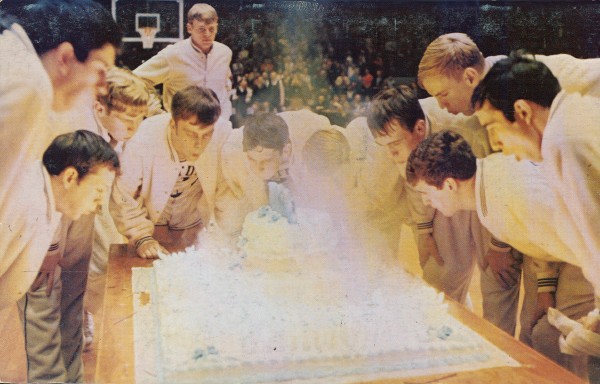 |
But to the rest of the world, Kentucky and Kansas we're still locked in a tight battle for the legitimate honor. According to the article shown at the right (published on January 8), Kansas stood at 997 victories to Kentucky's 995. The Jayhawks were considered the odds-on favorites to achieve the mark first, except for two things:
The first setback to the Jayhawks was they unexpectedly began to lose games. First Kansas was beaten by their arch-nemesis Missouri on January 11 and then got beat by Iowa State two days later (a team the Jayhawks had just beaten the week before by 33 points). Meanwhile Kentucky continued to slice through the Southeastern Conference opposition and steadily made up ground on the Jayhawks.
 |
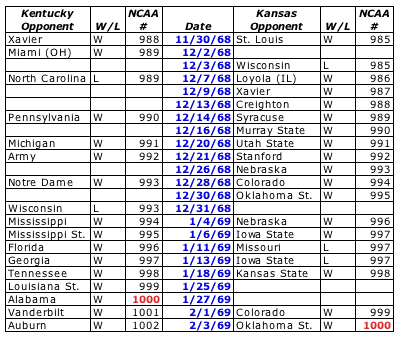 |
Table showing chronologically game-by-game cumulative wins using the NCAA numbers prior to the start of the 1968-69 season. |
Meanwhile Kentucky continued to win and assumed the title with a victory over Alabama (with Rupp's former player C.M. Newton coaching the Tide and facing his mentor for the first time) on January 27, 1969. Of course, Kentucky didn't celebrate this milestone as they had already celebrated and eaten their cake three weeks earlier. Instead Kentucky was celebrating Rupp's 800th victory, a milestone which of course the NCAA failed to recognize . . . until five victories later.
(JPS Note #1: Due to adjustments made to the record over the years, this victory total is no longer correct. The adjusted record which is now the official NCAA record shows Kentucky with two more victories than they claimed previously, which means that the actual game Kentucky hit the 1,000-victory mark was in a game against Tennessee on January 18th. In addition, Kansas' 1000th victory should now have occurred February 1, against Colorado based on current records. So Kansas must have modified their all-time record also at some point.)
Postscript - It would be nice to end the story there, but there were some other factors as play. Below is a coin minted by the Franklin Mint to commemorate the event. As you may notice, the date shown is January 13, 1969. This date is a game against Georgia, not the earlier game (1/6/1969) against Mississippi State (which included the five games in Tel Aviv) and not the later game (1/27/1969) against Alabama which was generally acknowledged at the time.
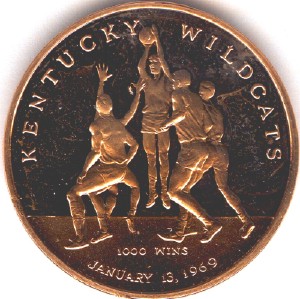 |
The additional three victories meant that even discounting the five victories in Israel that the NCAA didn't recognize, that UK now claimed that their 1,000th victory came against the Georgia Bulldogs on January 13, 1969.
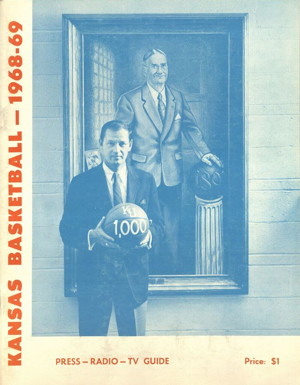 |
The inclusion of these two verified games does not completely explain how UK's record at the time squares with the current total as it is known that subsequent changes were made. For example, a game against Louisville in 1914 was added to the official record in the early 1990's. Looking at Media Guides from the late 1960's to the 1970's as compared to today, it's clear that changes were made to the early years. Without going thoroughly through every subsequent media guide, it's very difficult to know exactly when these changes were made, and more pertinent to me, why. (ie there may have been games that were dropped due to lack of first-hand evidence, which may have actually been played.)
I should note that for anyone who has spent any time digging through century-old microfilm looking for evidence of past games, it's not surprising in the least that previously undiscovered games can be located. It's actually to be expected given the lack of emphasis on basketball at the time and thus relatively poor record-keeping that was associated with it along with very poor communication when reporting game information. (especially accounting for the 1928 flood mentioned earlier in this page which literally wiped out all historical records at the time.)
All anyone needs to do is to locate an extremely old media guide for a school and compare the list of official games to what is claimed today. Most universities will have updated their list as the years go by and people have a chance to conduct more thorough research and better document the early eras.)
Return to top.
![]()
Return to Kentucky Wildcat Basketball Page.
Page last updated November 5, 2015